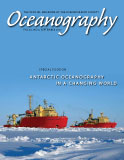Article Abstract
The 1962–1992 period spanning the research vessel Eltanin/Islas Orcadas expeditions to Ice Station Weddell, and the following World Ocean Circulation Experiment, may be viewed as the closing phase of an era of broad-based, circumpolar surveys of the Southern Ocean. Today’s investigations of the spatial and temporal dimensions of this complex ocean and its coupling to the climate system integrate observations from ships, aircraft, satellites, tethered instrumentation, and autonomous vehicles with numerical models. However, the adventure of obtaining Southern Ocean observations remains the same, requiring not just the right people and technology, but also special ships capable of working within the harsh Antarctic environment, where unknowns await discovery.

